The Basics
We have included this section to help you select the proper style and type of box to meet your packaging and shipping needs.
Measurements
|
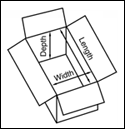 Box sizes are measured by using inner dimensions unless otherwise specified. The size of your contents actually determine the inner box dimensions. Domestically (within the United States), those dimensions are listed in the following sequence: Length (L) x Width (W) x Depth (D)*. Internationally, the dimensions are stated as Length (L) x Breadth (B) x Height (H).
Box sizes are measured by using inner dimensions unless otherwise specified. The size of your contents actually determine the inner box dimensions. Domestically (within the United States), those dimensions are listed in the following sequence: Length (L) x Width (W) x Depth (D)*. Internationally, the dimensions are stated as Length (L) x Breadth (B) x Height (H).
Dimensions are based on the opening of an assembled box. Looking at the opening, the longer of the two sides is considered the "length." The shorter of the two sides is the "width." The side perpendicular to the length and width is the "depth" of the box.
*Exceptions are bookfolds, bin boxes & divider bins where "width" precedes "length" & "depth" of the measurement sequence.
|
Back to Top
How To Measure A Box - The Quick Way
|
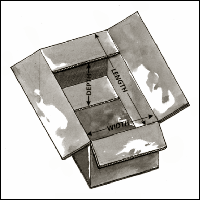 Looking at the opening of the box, measure the longest or length panel first. Using a tape measure, place it in the bottom of the box approximately one inch from the back wall and measure from left to right. Repeat the process for the shorter width panel. Then, folding a side flap inward until it is perpendicular to its vertical side wall, place the tape measure at the end of the flap and extend it downward until it rests on the inner flap at the bottom of the box (see illustration). This exercise will give you the depth dimension of the box.
Looking at the opening of the box, measure the longest or length panel first. Using a tape measure, place it in the bottom of the box approximately one inch from the back wall and measure from left to right. Repeat the process for the shorter width panel. Then, folding a side flap inward until it is perpendicular to its vertical side wall, place the tape measure at the end of the flap and extend it downward until it rests on the inner flap at the bottom of the box (see illustration). This exercise will give you the depth dimension of the box.
One-piece, die-cut boxes, such as the "mailer-style" with a tuck-in top, do not have flaps when assembled, but the measuring procedure is basically the same. For the box depth, use the inside back panel as it has a visible score line (crease separating back panel from lid). For the width of a die cut box, measure between the score lines found on the inside of the top or lid. And, of course, for the length of the box, place your measuring rule on the bottom of the box approximately one-inch from the back panel. Measure from left to right.
|
Back to Top
Box Construction - What you need to know
|
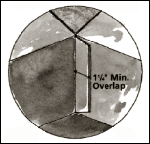 The "Manufacturer's Joint" is where the two ends of the side panels meet to form the box. At that point, the panels are fastened together with tape, staples or glue. This description applies to regular slotted shipping cartons (RSCs). The side panel thickness and content weight determine the type of seal used for the manufacturer's joint. For example, glue is used for most single wall boxes, but staples are found in some double wall and in most triple wall boxes. In contrast, die-cut boxes are one-piece panels scored and folded together. They do not have a manufacturer's joint.
The "Manufacturer's Joint" is where the two ends of the side panels meet to form the box. At that point, the panels are fastened together with tape, staples or glue. This description applies to regular slotted shipping cartons (RSCs). The side panel thickness and content weight determine the type of seal used for the manufacturer's joint. For example, glue is used for most single wall boxes, but staples are found in some double wall and in most triple wall boxes. In contrast, die-cut boxes are one-piece panels scored and folded together. They do not have a manufacturer's joint.
|
Back to Top
Box Strength
|
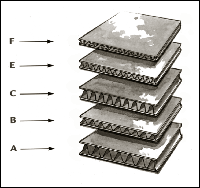 The strength of a corrugated box starts with its material. A corrugated sheet consists of two major components - linerboard and medium. Linerboard is the flat paper that covers both sides of the sheet and the medium is the "fluted" or arched paper found between both liners. The flute, when anchored to the linerboards with a starched-based adhesive, resists bending and pressure from all directions. When placed vertically on its ends, the flutes form vertical columns, capable of supporting considerable amounts of weight.
The strength of a corrugated box starts with its material. A corrugated sheet consists of two major components - linerboard and medium. Linerboard is the flat paper that covers both sides of the sheet and the medium is the "fluted" or arched paper found between both liners. The flute, when anchored to the linerboards with a starched-based adhesive, resists bending and pressure from all directions. When placed vertically on its ends, the flutes form vertical columns, capable of supporting considerable amounts of weight.
Flutes come in five basic heights and shapes - the most common are "B-Flute"(used for die-cut boxes) and "C-Flute (used for RSCs). B-flute is compressed and appears thinner, but don't be fooled. It is made with more paper to provide stronger side wall protection from blows and punctures. C-flute is taller, with more air space, but offers enhanced stacking strength. For excellent graphic reproduction, consider E-flute.
The amount of virgin pulp fibers and the length of those fibers in a corrugated sheet substantially contribute to box strength. For example, the difference between a 200# test box and a 275# test box is that the latter has more pulp fibers in its corrugated linerboard. The 200# test box is rated to hold up to 65 lbs. of box and contents while the 275# box can hold up to 95 lbs. A 350# test box is rated to hold up to 120 lbs. of box and contents. The following chart shows Bursting Test and Edge Crush Test performance standards of corrugated box liners based on the combined weight of a box and its contents.
Back to Top
| Linerboard Performance Standards |
Max Wt. Box/Contents
(lbs.) |
Min. Burst Test Single/Double Wall
(lbs. per sq. in.)* |
Min. Edge Crush Test (ECT)
(lbs. per in. width) |
| Single Wall Corrugated Boxes |
| 20 |
125 |
23 |
| 35 |
150 |
26 |
| 50 |
175 |
29 |
| 65 |
200 |
32 |
| 80 |
250 |
40 |
| 95 |
275 |
44 |
| 120 |
350 |
55 |
| Double Wall Corrugated Boxes |
| 80 |
200 |
42 |
| 100 |
275 |
48 |
| 120 |
350 |
51 |
| 140 |
400 |
61 |
| 160 |
500 |
71 |
| 180 |
600 |
82 |
| Triple Wall Corrugated Boxes |
| 240 |
700 |
67 |
| 260 |
900 |
80 |
| 280 |
1100 |
90 |
| 300 |
1300 |
112 |
* Minimum puncture test, Triple Wall board (in. oz. per in. of tear)
|
Back to Top
Look for the Manufacturer's Stamp
 A way to be sure that the material of the box that you're purchasing meets industry standards is to look for the Manufacturer's Certification Stamp, usually printed on one of the bottom flaps of the box. The stamp identifies the material as "singlewall," "doublewall" or "triplewall." It also certifies the Mullen Bursting Test ( most common is 200 lbs. per square inch) or the Edge Crush Test (ECT 32 lbs. per inch). The Mullen Test measures the bursting strength of the corrugated linerboard while the Edge Crush Test measures linerboard stacking strength. The 200 lbs. Mullen box and the 32 ECT box are comparable in stacking strength. But that is where the similarity ends. The Mullen Test box is better suited for the protection of heavier contents while the Edge Crush Test box provides lighter weight cartons with good stacking characteristics. When in doubt as to which box to use, always select the Mullen Test box because the construction of the linerboard cannot be altered. For example, 200# Mullen Test linerboard must be made of 42# per square inch basis weight paper and the medium or flute paper cannot be less than 23# per square inch basis weight.
A way to be sure that the material of the box that you're purchasing meets industry standards is to look for the Manufacturer's Certification Stamp, usually printed on one of the bottom flaps of the box. The stamp identifies the material as "singlewall," "doublewall" or "triplewall." It also certifies the Mullen Bursting Test ( most common is 200 lbs. per square inch) or the Edge Crush Test (ECT 32 lbs. per inch). The Mullen Test measures the bursting strength of the corrugated linerboard while the Edge Crush Test measures linerboard stacking strength. The 200 lbs. Mullen box and the 32 ECT box are comparable in stacking strength. But that is where the similarity ends. The Mullen Test box is better suited for the protection of heavier contents while the Edge Crush Test box provides lighter weight cartons with good stacking characteristics. When in doubt as to which box to use, always select the Mullen Test box because the construction of the linerboard cannot be altered. For example, 200# Mullen Test linerboard must be made of 42# per square inch basis weight paper and the medium or flute paper cannot be less than 23# per square inch basis weight.

Single Wall |

Double Wall |

Triple Wall |
Back to Top
When & What Box to Use
When to use a single wall 200# test box - when the box and contents weigh less than 65 lbs. This weight limit works fine for multiple light-weight items in a box or for a masterpack box where individual boxes are packed tightly in organized rows and stacks. If a single heavy item is to be shipped in a single wall, 200# test box, we recommend a weight limit of 45 lbs. or an upgrade to a 275# test single wall box. Simply apply common sense and always err on the conservative side.
Back to Top
Box Styles
Regular Slotted Carton (RSC)
|
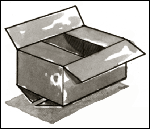 Also called shipping boxes, RSCs are the most commonly used boxes. They are usually kraft brown in color, have four flaps on the top and bottom and the side walls are sealed at one corner known as the "Manufacturer's Joint." This design is highly functional for most packing applications.
Also called shipping boxes, RSCs are the most commonly used boxes. They are usually kraft brown in color, have four flaps on the top and bottom and the side walls are sealed at one corner known as the "Manufacturer's Joint." This design is highly functional for most packing applications.
|
Back to Top
Multiple-Depth Carton (MDC)
|
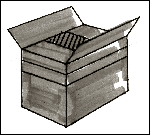 The same box design as an RSC, but with horizontal scores (creases) at selected depths along all four side walls. This feature gives you depth flexibility when packing a box. A Multiple-Depth Carton can be several boxes in one.
The same box design as an RSC, but with horizontal scores (creases) at selected depths along all four side walls. This feature gives you depth flexibility when packing a box. A Multiple-Depth Carton can be several boxes in one.
|
Back to Top
Half Slotted Carton (HSC)
|
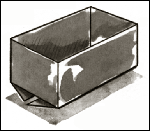 A variation of the RSC, the Half Slotted Carton has only one set of flaps. The opposite side of the box is completely open, allowing it to slide over an item. Envision the use of the box turned over so that the flaps are on the top. The covered item is usually attached to a pallet or other type of surface that serves as a separate bottom.
A variation of the RSC, the Half Slotted Carton has only one set of flaps. The opposite side of the box is completely open, allowing it to slide over an item. Envision the use of the box turned over so that the flaps are on the top. The covered item is usually attached to a pallet or other type of surface that serves as a separate bottom.
|
Back to Top
Full Overlap Slotted Carton (FOL)
|
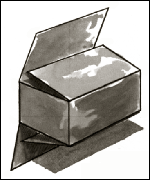 With a Full Overlap Slotted Carton, all "length" flaps are also equal to the width of the box. The flaps actually fold over one another to provide added strength and protection to the top and bottom.
With a Full Overlap Slotted Carton, all "length" flaps are also equal to the width of the box. The flaps actually fold over one another to provide added strength and protection to the top and bottom.
|
Back to Top
Five-Panel Folder (FPF)
|
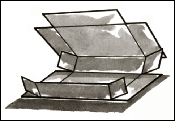 A Five-Panel Folder actually resembles a shallow-depth box when assembled. It is a one-piece box with an over-lapping top and over-lapping end panels. The functional design is also economical.
A Five-Panel Folder actually resembles a shallow-depth box when assembled. It is a one-piece box with an over-lapping top and over-lapping end panels. The functional design is also economical.
|
Back to Top
Snap-Bottom Carton (SBC)
|
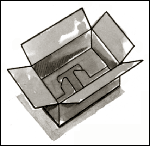 Available with tuck-in top or with RSC-style top flaps (shown). Also referred to as an "auto bottom" box. The bottom of the box snaps into place without tape for quick assembly. Best suited for light-weight products.
Available with tuck-in top or with RSC-style top flaps (shown). Also referred to as an "auto bottom" box. The bottom of the box snaps into place without tape for quick assembly. Best suited for light-weight products.
|
Back to Top
Full Telescope Design Carton (FTD)
|
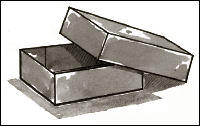 A two-piece box with a separate lid that fits over a bottom tray.
A two-piece box with a separate lid that fits over a bottom tray.
|
Back to Top
Half Telescope Design Carton (HTD)
|
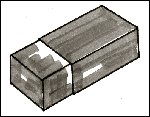 Two half-slotted cartons with one box slightly smaller to enable it to be inserted into the other box. Offers the ability to adjust the height or length of the box to fit your needs. Especially suitable for large, heavy items. For depth flexibility with smaller items, visit the "Multiple-Depth" box section of this web site.
Two half-slotted cartons with one box slightly smaller to enable it to be inserted into the other box. Offers the ability to adjust the height or length of the box to fit your needs. Especially suitable for large, heavy items. For depth flexibility with smaller items, visit the "Multiple-Depth" box section of this web site.
|
Back to Top
Two-Piece Carton With Separate Lid (CSL)
|
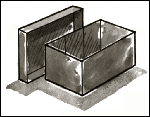 Die-cut box with open top and tray-style lid. Similar to a File Storage Box, but without the hand holes on either end. See "File Storage Boxes" section of this Web Site if you are looking for a box to store paper files.
Die-cut box with open top and tray-style lid. Similar to a File Storage Box, but without the hand holes on either end. See "File Storage Boxes" section of this Web Site if you are looking for a box to store paper files.
|
Back to Top
Double Cover Carton (DC)
|
 This style of box is frequently used for tall or large, heavy items. A three-piece box, the Double Cover Carton is constructed of a four-panel tube that serves as the side panels and two interchangeable trays that serve as the top and bottom of the box.
This style of box is frequently used for tall or large, heavy items. A three-piece box, the Double Cover Carton is constructed of a four-panel tube that serves as the side panels and two interchangeable trays that serve as the top and bottom of the box.
|
Back to Top
One-Piece Folder (OPF)
|
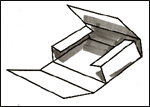 Commonly called, "Bookfolds" or Bookwraps," the One Piece Folder has a flat bottom with two short flaps forming the sides at each end and two longer, wider flaps that form the front, back and top of the box. The wider flaps either meet or overlap on the top, depending on the depth of the contents. The four panels of a Bookfold are usually scored (creased) at multiple depths. One-Piece Folders are used to package shallow depth items such as books and pictures. Usually manufactured with white board.
Commonly called, "Bookfolds" or Bookwraps," the One Piece Folder has a flat bottom with two short flaps forming the sides at each end and two longer, wider flaps that form the front, back and top of the box. The wider flaps either meet or overlap on the top, depending on the depth of the contents. The four panels of a Bookfold are usually scored (creased) at multiple depths. One-Piece Folders are used to package shallow depth items such as books and pictures. Usually manufactured with white board.
|
Back to Top
Mailer-Style Boxes (MSB)
|
A one-piece die-cut box that is assembled without tape. Construction includes double-layer protection on the sides and bottom of the box. Available in two popular styles - with a tuck-in top or with a locking cover, also known as a "cherry lock" design. (See illustrations) Mailer-Style Boxes are exceptionally strong and can withstand the most rigorous treatment during shipment.
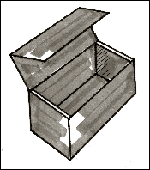
Tuck-In Top |
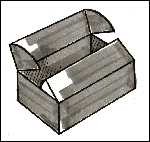
Locking Cover |
|
Back to Top
Bin Boxes (BB)
|
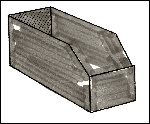 Another one piece die cut box that can be assembled without tape or glue. Often referred to as shelf boxes for parts and other small items, Bin Boxes have an open top to allow you to see and reach inside. Measured by width, length and depth. These long, narrow boxes can significantly increase storage space. Available in multiple widths and in four different lengths.
Another one piece die cut box that can be assembled without tape or glue. Often referred to as shelf boxes for parts and other small items, Bin Boxes have an open top to allow you to see and reach inside. Measured by width, length and depth. These long, narrow boxes can significantly increase storage space. Available in multiple widths and in four different lengths.
|
Back to Top
Divider Bins (DB)
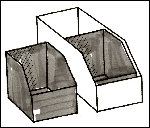
Divider Bins are smaller, open top boxes. They are usually used in conjunction with Bin Boxes to create multiple compartments within a Bin Box.
|
Back to Top
|

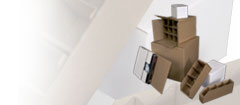
 Box sizes are measured by using inner dimensions unless otherwise specified. The size of your contents actually determine the inner box dimensions. Domestically (within the United States), those dimensions are listed in the following sequence: Length (L) x Width (W) x Depth (D)*. Internationally, the dimensions are stated as Length (L) x Breadth (B) x Height (H).
Box sizes are measured by using inner dimensions unless otherwise specified. The size of your contents actually determine the inner box dimensions. Domestically (within the United States), those dimensions are listed in the following sequence: Length (L) x Width (W) x Depth (D)*. Internationally, the dimensions are stated as Length (L) x Breadth (B) x Height (H). Looking at the opening of the box, measure the longest or length panel first. Using a tape measure, place it in the bottom of the box approximately one inch from the back wall and measure from left to right. Repeat the process for the shorter width panel. Then, folding a side flap inward until it is perpendicular to its vertical side wall, place the tape measure at the end of the flap and extend it downward until it rests on the inner flap at the bottom of the box (see illustration). This exercise will give you the depth dimension of the box.
Looking at the opening of the box, measure the longest or length panel first. Using a tape measure, place it in the bottom of the box approximately one inch from the back wall and measure from left to right. Repeat the process for the shorter width panel. Then, folding a side flap inward until it is perpendicular to its vertical side wall, place the tape measure at the end of the flap and extend it downward until it rests on the inner flap at the bottom of the box (see illustration). This exercise will give you the depth dimension of the box. The "Manufacturer's Joint" is where the two ends of the side panels meet to form the box. At that point, the panels are fastened together with tape, staples or glue. This description applies to regular slotted shipping cartons (RSCs). The side panel thickness and content weight determine the type of seal used for the manufacturer's joint. For example, glue is used for most single wall boxes, but staples are found in some double wall and in most triple wall boxes. In contrast, die-cut boxes are one-piece panels scored and folded together. They do not have a manufacturer's joint.
The "Manufacturer's Joint" is where the two ends of the side panels meet to form the box. At that point, the panels are fastened together with tape, staples or glue. This description applies to regular slotted shipping cartons (RSCs). The side panel thickness and content weight determine the type of seal used for the manufacturer's joint. For example, glue is used for most single wall boxes, but staples are found in some double wall and in most triple wall boxes. In contrast, die-cut boxes are one-piece panels scored and folded together. They do not have a manufacturer's joint. The strength of a corrugated box starts with its material. A corrugated sheet consists of two major components - linerboard and medium. Linerboard is the flat paper that covers both sides of the sheet and the medium is the "fluted" or arched paper found between both liners. The flute, when anchored to the linerboards with a starched-based adhesive, resists bending and pressure from all directions. When placed vertically on its ends, the flutes form vertical columns, capable of supporting considerable amounts of weight.
The strength of a corrugated box starts with its material. A corrugated sheet consists of two major components - linerboard and medium. Linerboard is the flat paper that covers both sides of the sheet and the medium is the "fluted" or arched paper found between both liners. The flute, when anchored to the linerboards with a starched-based adhesive, resists bending and pressure from all directions. When placed vertically on its ends, the flutes form vertical columns, capable of supporting considerable amounts of weight. A way to be sure that the material of the box that you're purchasing meets industry standards is to look for the Manufacturer's Certification Stamp, usually printed on one of the bottom flaps of the box. The stamp identifies the material as "singlewall," "doublewall" or "triplewall." It also certifies the Mullen Bursting Test ( most common is 200 lbs. per square inch) or the Edge Crush Test (ECT 32 lbs. per inch). The Mullen Test measures the bursting strength of the corrugated linerboard while the Edge Crush Test measures linerboard stacking strength. The 200 lbs. Mullen box and the 32 ECT box are comparable in stacking strength. But that is where the similarity ends. The Mullen Test box is better suited for the protection of heavier contents while the Edge Crush Test box provides lighter weight cartons with good stacking characteristics. When in doubt as to which box to use, always select the Mullen Test box because the construction of the linerboard cannot be altered. For example, 200# Mullen Test linerboard must be made of 42# per square inch basis weight paper and the medium or flute paper cannot be less than 23# per square inch basis weight.
A way to be sure that the material of the box that you're purchasing meets industry standards is to look for the Manufacturer's Certification Stamp, usually printed on one of the bottom flaps of the box. The stamp identifies the material as "singlewall," "doublewall" or "triplewall." It also certifies the Mullen Bursting Test ( most common is 200 lbs. per square inch) or the Edge Crush Test (ECT 32 lbs. per inch). The Mullen Test measures the bursting strength of the corrugated linerboard while the Edge Crush Test measures linerboard stacking strength. The 200 lbs. Mullen box and the 32 ECT box are comparable in stacking strength. But that is where the similarity ends. The Mullen Test box is better suited for the protection of heavier contents while the Edge Crush Test box provides lighter weight cartons with good stacking characteristics. When in doubt as to which box to use, always select the Mullen Test box because the construction of the linerboard cannot be altered. For example, 200# Mullen Test linerboard must be made of 42# per square inch basis weight paper and the medium or flute paper cannot be less than 23# per square inch basis weight.


 Also called shipping boxes, RSCs are the most commonly used boxes. They are usually kraft brown in color, have four flaps on the top and bottom and the side walls are sealed at one corner known as the "Manufacturer's Joint." This design is highly functional for most packing applications.
Also called shipping boxes, RSCs are the most commonly used boxes. They are usually kraft brown in color, have four flaps on the top and bottom and the side walls are sealed at one corner known as the "Manufacturer's Joint." This design is highly functional for most packing applications. The same box design as an RSC, but with horizontal scores (creases) at selected depths along all four side walls. This feature gives you depth flexibility when packing a box. A Multiple-Depth Carton can be several boxes in one.
The same box design as an RSC, but with horizontal scores (creases) at selected depths along all four side walls. This feature gives you depth flexibility when packing a box. A Multiple-Depth Carton can be several boxes in one. A variation of the RSC, the Half Slotted Carton has only one set of flaps. The opposite side of the box is completely open, allowing it to slide over an item. Envision the use of the box turned over so that the flaps are on the top. The covered item is usually attached to a pallet or other type of surface that serves as a separate bottom.
A variation of the RSC, the Half Slotted Carton has only one set of flaps. The opposite side of the box is completely open, allowing it to slide over an item. Envision the use of the box turned over so that the flaps are on the top. The covered item is usually attached to a pallet or other type of surface that serves as a separate bottom. With a Full Overlap Slotted Carton, all "length" flaps are also equal to the width of the box. The flaps actually fold over one another to provide added strength and protection to the top and bottom.
With a Full Overlap Slotted Carton, all "length" flaps are also equal to the width of the box. The flaps actually fold over one another to provide added strength and protection to the top and bottom.  A Five-Panel Folder actually resembles a shallow-depth box when assembled. It is a one-piece box with an over-lapping top and over-lapping end panels. The functional design is also economical.
A Five-Panel Folder actually resembles a shallow-depth box when assembled. It is a one-piece box with an over-lapping top and over-lapping end panels. The functional design is also economical. Available with tuck-in top or with RSC-style top flaps (shown). Also referred to as an "auto bottom" box. The bottom of the box snaps into place without tape for quick assembly. Best suited for light-weight products.
Available with tuck-in top or with RSC-style top flaps (shown). Also referred to as an "auto bottom" box. The bottom of the box snaps into place without tape for quick assembly. Best suited for light-weight products. A two-piece box with a separate lid that fits over a bottom tray.
A two-piece box with a separate lid that fits over a bottom tray. Two half-slotted cartons with one box slightly smaller to enable it to be inserted into the other box. Offers the ability to adjust the height or length of the box to fit your needs. Especially suitable for large, heavy items. For depth flexibility with smaller items, visit the "
Two half-slotted cartons with one box slightly smaller to enable it to be inserted into the other box. Offers the ability to adjust the height or length of the box to fit your needs. Especially suitable for large, heavy items. For depth flexibility with smaller items, visit the " Die-cut box with open top and tray-style lid. Similar to a File Storage Box, but without the hand holes on either end. See "
Die-cut box with open top and tray-style lid. Similar to a File Storage Box, but without the hand holes on either end. See " This style of box is frequently used for tall or large, heavy items. A three-piece box, the Double Cover Carton is constructed of a four-panel tube that serves as the side panels and two interchangeable trays that serve as the top and bottom of the box.
This style of box is frequently used for tall or large, heavy items. A three-piece box, the Double Cover Carton is constructed of a four-panel tube that serves as the side panels and two interchangeable trays that serve as the top and bottom of the box. Commonly called, "Bookfolds" or Bookwraps," the One Piece Folder has a flat bottom with two short flaps forming the sides at each end and two longer, wider flaps that form the front, back and top of the box. The wider flaps either meet or overlap on the top, depending on the depth of the contents. The four panels of a Bookfold are usually scored (creased) at multiple depths. One-Piece Folders are used to package shallow depth items such as books and pictures. Usually manufactured with white board.
Commonly called, "Bookfolds" or Bookwraps," the One Piece Folder has a flat bottom with two short flaps forming the sides at each end and two longer, wider flaps that form the front, back and top of the box. The wider flaps either meet or overlap on the top, depending on the depth of the contents. The four panels of a Bookfold are usually scored (creased) at multiple depths. One-Piece Folders are used to package shallow depth items such as books and pictures. Usually manufactured with white board. 

 Another one piece die cut box that can be assembled without tape or glue. Often referred to as shelf boxes for parts and other small items, Bin Boxes have an open top to allow you to see and reach inside. Measured by width, length and depth. These long, narrow boxes can significantly increase storage space. Available in multiple widths and in four different lengths.
Another one piece die cut box that can be assembled without tape or glue. Often referred to as shelf boxes for parts and other small items, Bin Boxes have an open top to allow you to see and reach inside. Measured by width, length and depth. These long, narrow boxes can significantly increase storage space. Available in multiple widths and in four different lengths. 

